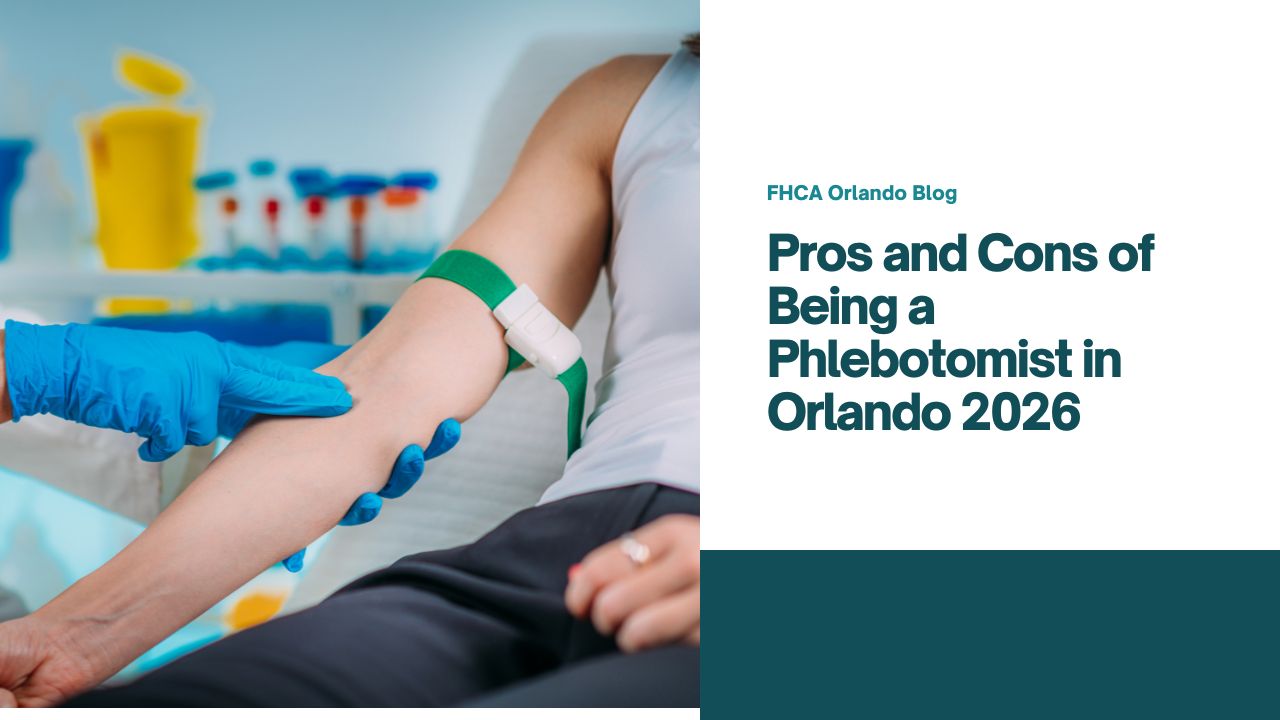A Comprehensive Guide to Mastering Phlebotomy Procedures
Nov 20, 2024
Phlebotomy is a precise and essential skill in healthcare, requiring careful preparation, technique, and adherence to safety protocols.
This guide provides an in-depth look at performing a phlebotomy procedure from start to finish, with practical tips and essential equipment outlined for optimal results.
Understanding the phlebotomy procedure step-by-step is crucial for both practice and documentation; detailing this knowledge on your resume for phlebotomist applications can demonstrate your proficiency to potential employers
For those interested in the steps to become a phlebotomist, mastering these skills is a critical part of the journey.
Step-by-Step to perform a phlebotomy procedure
Why is phlebotomy important? By following each step of the process, phlebotomists ensure that blood samples are collected efficiently and safely, providing critical information for patient diagnosis and treatment.
1. Phlebotomy preparation
Proper preparation is key to a successful phlebotomy procedure:
- Gather Supplies: Ensure that all necessary equipment, including needles, collection tubes, and PPE, are ready and sterile.
- Verify the Patient and Order: Confirm the patient’s identity and check the order details to ensure accuracy.
- Review Patient Information: Understand any patient-specific needs or conditions, such as allergies or medical history, that may impact the procedure.
2. Prepare the patient
A well-prepared patient contributes to a smooth blood draw:
- Explain the Process to the Patient: Describe each step to help alleviate any anxiety and build trust.
- Position the Patient Correctly: Ensure the patient is seated or lying down in a comfortable, secure position to prevent fainting or movement during the procedure.
3. Performing the blood draw
Executing the blood draw requires precise technique and adherence to safety protocols:
- Sanitize Hands and Use PPE: Practice proper hygiene and wear gloves and other protective equipment.
- Apply the Tourniquet: Secure the tourniquet above the draw site to make veins more visible.
- Prepare the Site: Clean the area with an alcohol prep pad to prevent infection.
- Anchor the Vein and Insert the Needle: Stabilize the vein with one hand while inserting the needle with a steady, controlled motion.
- Collect Blood Samples: Use appropriate collection tubes, ensuring correct volume and order of draw.
4. Finalize the procedure
Completing the procedure safely is crucial for patient care and sample quality:
- Withdraw the Needle and Apply Pressure: Remove the needle smoothly, immediately applying gauze and pressure to the site.
- Dispose of Materials Safely: Place the needle and other disposable items in the sharps container.
- Label and Transport Samples: Label each sample accurately and prepare them for prompt transport to the lab.
5. Post-procedure care
Post-procedure care supports patient comfort and recovery:
- Assist the Patient with Recovery: Provide aftercare instructions and ensure the patient is stable before leaving.
Essential equipment for phlebotomy procedures
Using the right equipment is critical for efficient and safe blood draws. Here is a checklist of essential items, explained with reference to Phlebotomy medical terminology:
- Needles: Various sizes for different vein types and patient needs.
- Vacutainer or Syringe: Devices for drawing and collecting blood.
- Tourniquet: Used to increase venous pressure, making veins easier to locate.
- Alcohol Prep Pads: Sterilize the puncture site to reduce infection risk.
- Gauze Pads: Applied post-draw to stop bleeding.
- Bandages or Adhesive Tape: Used to secure the gauze and protect the puncture site.
- Collection Tubes: Different tubes for specific tests, ensuring proper sample handling.
- Sharps Disposal Container: For safe disposal of needles and other sharp items.
- Gloves: Mandatory PPE for protecting both patient and phlebotomist.
- Labels: To mark samples accurately and prevent identification errors.
Phlebotomy safety protocols
Safety is paramount in phlebotomy, where maintaining sterile technique and adhering to regulations protects patients and staff. Day in life as a phlebotomist outlines the daily commitment to these safety practices:
- Maintaining Sterile Technique and Universal Precautions: Preventing contamination is achieved through rigorous hand hygiene, proper PPE, and sterile techniques.
- Proper Disposal of Medical Waste and Sharps: Sharps containers and regulated waste disposal are essential for maintaining a safe work environment.
- Adhering to Regulatory Guidelines: Compliance with healthcare standards ensures patient safety and quality control in all procedures.
"All items to be used on more than one patient should be designed so that they can be cleaned and disinfected. Such items include laboratory transport boxes or trays, tourniquets, evacuated tube holders, scissors and so on. Also, it is best to buy high-quality items even if they are more expensive."
Overcoming common phlebotomy challenges
Phlebotomists may encounter challenges that require adaptability and problem-solving. Become a pediatric phlebotomist for more insight into specialized techniques.
Deal with difficult veins
For patients with small or deep veins, phlebotomists can use techniques like warming the area with a compress, which helps dilate veins. A smaller gauge or butterfly needle may also ease access. Adjusting the tourniquet or having patients lower their arm or clench their fist can further improve visibility, making the draw smoother and more successful.
Manage patient anxiety and discomfort
Calm, clear communication can significantly ease patient anxiety. Phlebotomists can explain the procedure in simple terms and engage patients in light conversation to distract them.
Techniques like guided breathing, allowing patients to sit or lie down as they prefer, and offering gentle reassurance help create a more comfortable experience.
Prevent sample contamination
To maintain sample integrity, phlebotomists follow sterile procedures, using fresh gloves, alcohol prep pads, and sterile needles with each draw.
Adhering to the correct order of draw minimizes contamination risk, while immediate labeling and sealing ensure samples are handled properly for accurate testing results.
Troubleshoot failed blood draws
If a blood draw is unsuccessful, slight adjustments to the needle angle or reattempting with an alternate vein can improve results.
Phlebotomists are trained to try different sites, including smaller veins in the hand or wrist if necessary, to complete the draw efficiently while minimizing patient discomfort.
Ensure Proper needle insertion angle and depth
Phlebotomists use a standard insertion angle, typically 15-30 degrees, to achieve accurate, comfortable blood draws.
Proper insertion depth is crucial; shallow insertion risks an incomplete draw, while going too deep can miss the vein. These refined techniques ensure successful draws with minimal discomfort.
Handle common equipment issues
Quickly resolving equipment issues is vital for efficient procedures. Phlebotomists are prepared to troubleshoot, whether adjusting a tourniquet, switching needles, or handling collection tube issues. Familiarity with equipment keeps the process smooth and helps maintain patient comfort and procedure flow.
Essential phlebotomy tips
Mastering phlebotomy involves more than just technical skills; it requires a blend of confidence, empathy, and precision. Here are some essential tips for delivering effective and patient-centered care:
- Project Calmness and Confidence: A calm demeanor reassures patients, especially those nervous about needles. Confidence in your skills not only builds patient trust but also enhances your own efficiency and precision during procedures.
- Master Needle Insertion Technique: Consistent practice with needle insertion angles and depths ensures successful, comfortable blood draws. Perfecting this technique minimizes patient discomfort and improves the accuracy and speed of each procedure.
- Prepare for Challenging Veins: Some patients have hard-to-locate veins, so be ready with strategies like warming the area, using a butterfly needle, or reapplying the tourniquet. Flexibility and adaptability are key for a smooth draw.
- Keep Patients Informed: Clear, simple explanations help reduce patient anxiety and foster cooperation. Informing patients about each step gives them reassurance and contributes to a positive experience.
- Prioritize Hygiene and Safety: Strict hygiene practices, including fresh gloves, clean needles, and proper disposal, are essential to patient safety and infection control. Adhering to these protocols protects both patients and healthcare staff.
By investing in CEU-accredited venipuncture and phlebotomy training, healthcare professionals enhance their knowledge, skills, and career trajectory, ensuring they remain vital contributors to the evolving healthcare landscape.









